
The Battle of Adrianople occurred around Adrianople on April 14, 1205, between Bulgarians and Cumans under Tsar Kaloyan of Bulgaria, and Crusaders under Baldwin I, who only months before had been crowned Emperor of Constantinople, allied with Venetians under Doge Enrico Dandolo. The battle was won by the Bulgarian Empire after a successful ambush.
Kaloyan or Kalojan, also known as Ivan I, Ioannitsa or Johannitsa, the Romanslayer, was emperor or tsar of Bulgaria from 1196 to 1207. He was the younger brother of Theodor and Asen, who led the anti-Byzantine uprising of the Bulgarians and Vlachs in 1185. The uprising ended with the restoration of Bulgaria as an independent state. He spent a few years as a hostage in Constantinople in the late 1180s. Theodor, crowned Emperor Peter II, made him his co-ruler after Asen was murdered in 1196. A year later, Peter was also murdered, and Kaloyan became the sole ruler of Bulgaria.
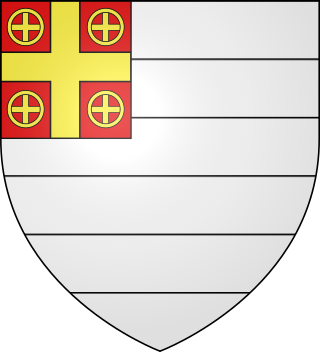
The House of Asen, also Asen dynasty or the Asenids, founded and ruled a medieval Bulgarian state, called in modern historiography the Second Bulgarian Empire, between 1185 and 1280.

Boril was the emperor (tsar) of Bulgaria from 1207 to 1218. He was the son of an unnamed sister of his predecessor, Kaloyan and Kaloyan's brothers, Peter II and Ivan Asen I, who had restored the independent Bulgarian state. After Kaloyan died unexpectedly in October 1207, Boril married his widow, a Cuman princess and seized the throne. His cousin, Ivan Asen, fled from Bulgaria, enabling Boril to strengthen his position. His other kinsmen, Strez and Alexius Slav, refused to acknowledge him as the lawful monarch. Strez took possession of the land between the Struma and Vardar rivers with the support of Stefan Nemanjić of Serbia. Alexius Slav secured his rule in the Rhodope Mountains with the assistance of Henry, the Latin Emperor of Constantinople.

The Second Bulgarian Empire was a medieval Bulgarian state that existed between 1185 and 1396. A successor to the First Bulgarian Empire, it reached the peak of its power under Tsars Kaloyan and Ivan Asen II before gradually being conquered by the Ottomans in the late 14th century.
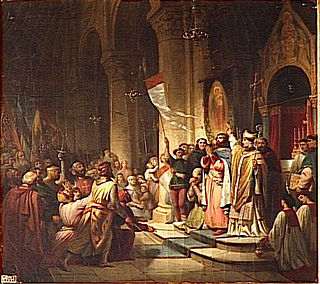
The Bulgarian–Latin wars were a series of conflicts between the Second Bulgarian Empire (1185–1396) and the Latin Empire (1204–61). The wars affected the northern border of the Latin Empire throughout its existence.

Dobrotitsa was a Bulgarian noble, ruler of the de facto independent Principality of Karvuna and the Kaliakra fortress from 1354 to 1379–1386.
Medieval Bulgarian coinage were the coins minted by the Bulgarian Emperors during the Middle Ages at the time of the Second Bulgarian Empire.
The battle of Thessalonica was fought between the Bulgarian and the Byzantine Empires in the summer of 1014 near the city of Thessalonica in contemporary northern Greece. The Bulgarian army under the command of Nestoritsa was defeated by the Byzantines led by the governor of Thessalonica Theophylactus Botaniates and it was unable to divert the main Byzantine forces who were attacking the Bulgarian ramparts between the Belasitsa and Ograzhden mountains.
The Battle of Strumica took place in August 1014, near Strumica, present-day North Macedonia, between Bulgarian and Byzantine forces. Bulgarian troops under Emperor Samuil's son Gavril Radomir defeated the army of the governor of Thessaloniki, Theophylactus Botaniates, who perished in the battle. After his death the Byzantine Emperor Basil II was forced to pull back from Bulgaria and was unable to take advantage of his success in the recent Battle of Kleidion.

The Battle of Philippopolis or Battle of Plovdiv took place on 30 June 1208 in the surroundings of Philippopolis between the armies of the Bulgarian Empire and the Latin Empire. The Crusaders were victorious.
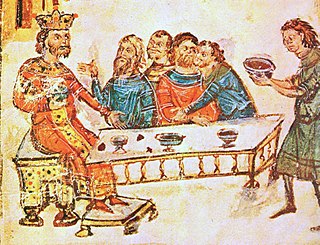
The medieval Bulgarian army was the primary military body of the First and the Second Bulgarian Empires, and some Puppet states of the former, like the Despotate of Dobruja. During the first decades after the foundation of the country, the army consisted of a Bulgar cavalry and a Slavic infantry. The core of the Bulgarian army was the heavy cavalry, which consisted of ca. 12,000 heavily armed riders. At its height in the 9th and 10th centuries, it was one of the most formidable military forces in Europe and was feared by its enemies. There are several documented cases of Byzantine commanders abandoning an invasion because of a reluctance to confront the Bulgarian army on its home territory.

Kaloyan and Desislava were 13th-century Bulgarian nobles, sebastocrators of Sredets (Sofia) and the surrounding region during the Asen dynasty of the Second Bulgarian Empire. They are credited as main donors and patrons of the Boyana Church. Their portraits, created in 1259 by the painters of Tarnovo Artistic School in Boyana Church are considered by many leading experts as the first Renaissance images in European art Many art historians defined these frescoes as one of the most remarkable works of the Palaeologan Renaissance.
Strez was a medieval, semi-independent Bulgarian sebastokrator. He was a member of the Asen dynasty and a cousin or a brother of Boril of Bulgaria. A major contender for the Bulgarian throne, Strez initially opposed the ascension of his close relative Tsar Boril. He fled to Serbia, where he accepted the vassalage of Grand Prince Stefan Nemanjić, and Serbian support helped him establish himself as a largely independent ruler in a large part of the region of Macedonia. However, Strez turned against his suzerains to become a Bulgarian vassal and joined forces with his former enemy Boril against the Latins and then Serbia. Strez died amidst a major anti-Serbian campaign under unclear circumstances, sometimes described as a Serbian plot.
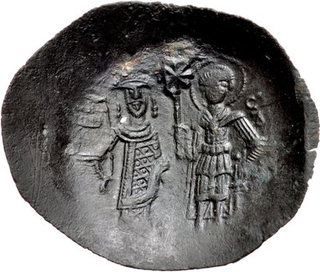
Ivan Asen II, also known as John Asen II, was Emperor (Tsar) of Bulgaria from 1218 to 1241. He was still a child when his father Ivan Asen I – one of the founders of the Second Bulgarian Empire – was killed in 1196. His supporters tried to secure the throne for him after his uncle, Kaloyan, was murdered in 1207, but Kaloyan's other nephew, Boril, overcame them. Ivan Asen fled from Bulgaria and settled in the Rus' principalities.
Prespa was a medieval town, situated in the homonymous area in south-western Macedonia. It was a residence and burial place of the Bulgarian emperor Samuel and according to some sources capital of the First Bulgarian Empire and seat of the Bulgarian Patriarchate in the last decades of the 10th century.
Joachim III was the Patriarch of the Bulgarian Orthodox Church between c. 1282 and 1300, when the Second Bulgarian Empire reached its lowest point of decline during the reign of the emperors George Terter I, Smilets and Chaka. He was executed for treason by emperor Theodore Svetoslav in 1300. The Church did not recognize his guilt and his name was included in the list of Bulgarian Patriarchs in the Book of Boril. His seat was Tarnovo, the capital of Bulgaria.
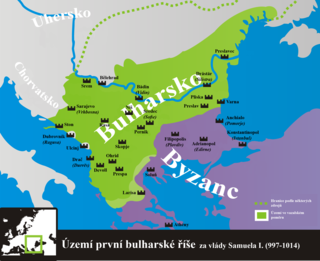
Peter and Boyan were late-10th century Bulgarian nobles (boyars) from Byzantine-administered northeastern Bulgaria. They are mentioned in Annales seu cronicae incliti Regni Poloniae by Jan Długosz in the context of their successful struggle against Byzantium:
Two Bulgarian warlords – Peter and Boyan – began a war against the Greeks, and after securing a few victories, worried Constantine's country so much, that its power was shaken and diminished for a long time.